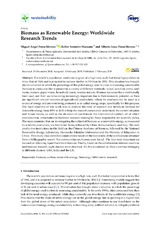Biomass as Renewable Energy: Worldwide Research Trends
Autor
Perea-Moreno, Miguel Ángel
Samerón-Manzano, Esther
Perea Moreno, Alberto Jesús
Editor
MDPIFecha
2019Materia
BiomassCarbon
Renewable energy
Bioenergy
Bibliometric research
METS:
Mostrar el registro METSPREMIS:
Mostrar el registro PREMISMetadatos
Mostrar el registro completo del ítemResumen
The world’s population continues to grow at a high rate, such that today’s population is twice that of 1960, and is projected to increase further to 9 billion by 2050. This situation has brought about a situation in which the percentage of the global energy used in cities is increasing considerably. Biomass is a resource that is present in a variety of different materials: wood, sawdust, straw, seed waste, manure, paper waste, household waste, wastewater, etc. Biomass resources have traditionally been used, and their use is becoming increasingly important due to their economic potential, as there are significant annual volumes of agricultural production, whose by-products can be used as a source of energy and are even being promoted as so-called energy crops, specifically for this purpose. The main objective of this work was to analyze the state of research and trends in biomass for renewable energy from 1978 to 2018 to help the research community understand the current situation and future trends, as well as the situation of countries in the international context, all of which provides basic information to facilitate decision-making by those responsible for scientific policy. The main countries that are investigating the subject of biomass as a renewable energy, as measured by scientific production, are the United States, followed by China, India, Germany and Italy. The most productive institutions in this field are the Chinese Academy of Sciences, followed by the National Renewable Energy Laboratory, Danmarks Tekniske Universitet and the Ministry of Education in China. This study also identifies communities based on the keywords of the publications obtained from a bibliographic search. Six communities or clusters were found. The two most important are focused on obtaining liquid fuels from biomass. Finally, based on the collaboration between countries and biomass research, eight clusters were observed. All this is centered on three countries belonging to different clusters: USA, India and the UK.

